Narrowband IoT Market Size
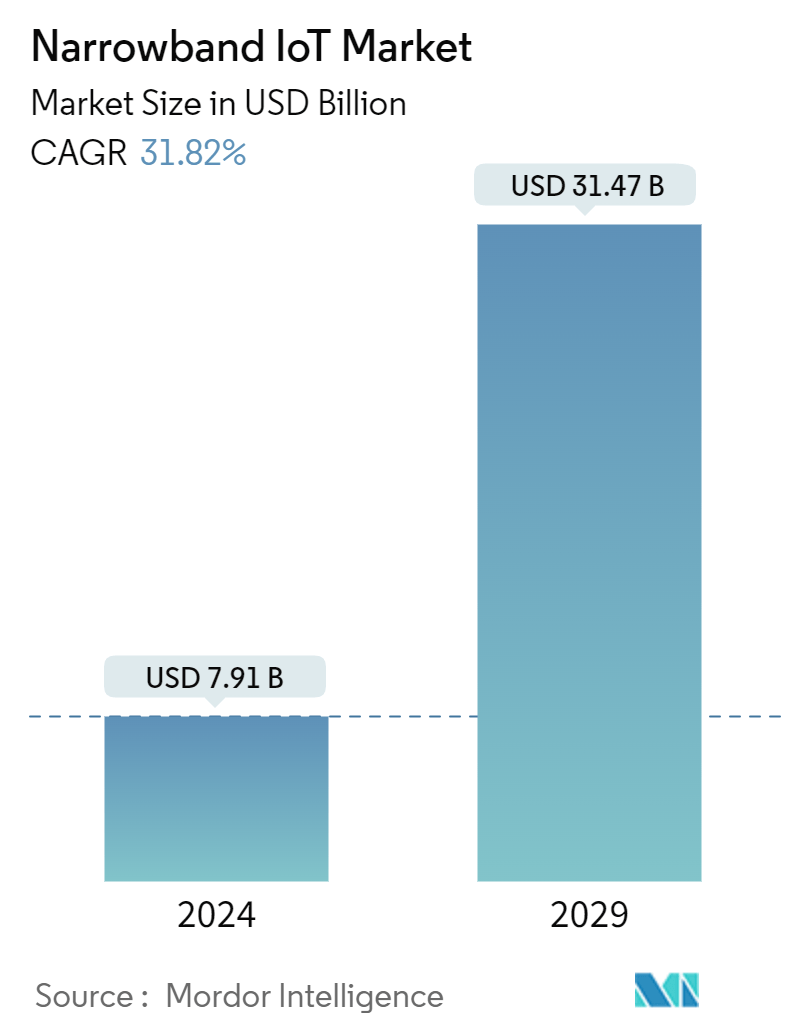
| Study Period | 2019 - 2029 |
| Market Size (2024) | USD 7.91 Billion |
| Market Size (2029) | USD 31.47 Billion |
| CAGR (2024 - 2029) | 31.82 % |
| Fastest Growing Market | Asia Pacific |
| Largest Market | North America |
Major Players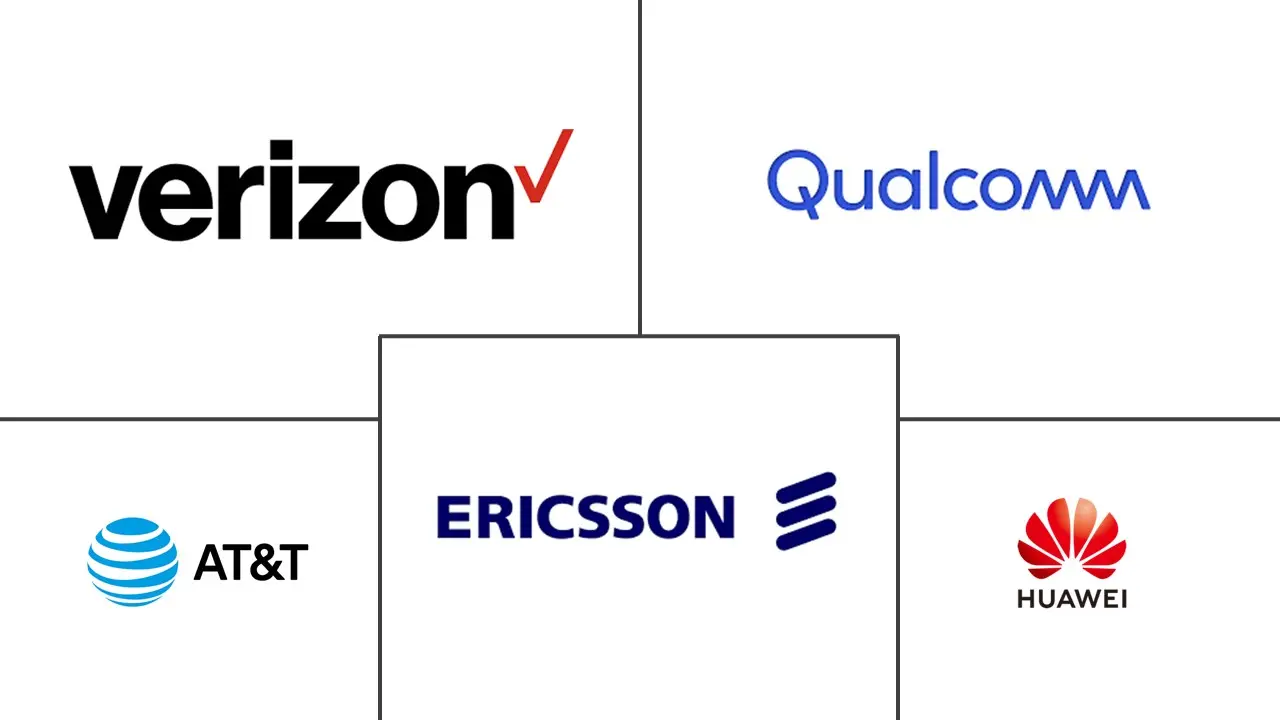
*Disclaimer: Major Players sorted in no particular order |
Narrowband IoT Market Analysis
The Narrowband IoT Market size is estimated at USD 7.91 billion in 2024, and is expected to reach USD 31.47 billion by 2029, growing at a CAGR of 31.82% during the forecast period (2024-2029).
As a relatively new technology, NB-IoT is still in the early phases of adoption. However, in the upcoming years, it is anticipated to increase quickly.
- The NarrowBand-Internet of Things (NB-IoT) is a standards-based low-power wide area (LPWA) technology designed to support a variety of innovative IoT products and services. NB-IoT dramatically increases system capacity, spectrum efficiency, and user device power consumption, especially in deep coverage.
- NB-IoT is a wireless telecommunications technology standard created by 3GPP, the worldwide standards body responsible for all significant mobile telecommunications standards, including 4G standards like LTE and 5G standards like 5G NR. The NB-IoT modules' low power consumption during signal processing contributes to a ten-year battery life.
- All significant manufacturers of mobile devices, chipsets, and modules support NB-IoT, which can coexist alongside 2G, 3G, and 4G mobile networks. Additionally, it gains the advantages of all mobile networks' security and privacy characteristics, including support for user identity confidentiality, entity authentication, confidentiality, data integrity, and mobile equipment identification.
- In particular, NB-IoT is used in smart cities, smart agricultural, and asset-tracking applications that need low data rates, long battery life, and wide-area coverage. It is ideal for IoT applications that demand massive connectivity since it enables the connection of many devices, generally in hundreds or even millions.
- The wearables sector is also predicted to contribute a major portion of the market due to the fast expanding demand for sports, fitness, and healthcare gadgets for personal care and diagnostics. While the younger population is encouraged to use sports and fitness bands due to rising disposable income levels and increased knowledge of the benefits of physical fitness, the use of healthcare bands is rising in developed nations.
- As a result of the NB-IoT technology's fast-expanding uses, an increasing number of technology firms and telecommunications service providers are projected to develop NB-IoT devices and roll out related services, accelerating market growth throughout the projection period. Big data analytics, artificial intelligence (AI), and machine learning (ML) advancements would allow firms to study enormous volumes of data obtained by watching and monitoring activities via IoT networks.
- Automobile manufacturers are responding to passenger safety concerns by implementing new technology that will undoubtedly provide safer, more convenient, and cost-effective transportation. As a result, NB-IoT is increasingly being used in the automobile industry due to its ability to precisely track vehicles, identify and avoid major traffic jams, and contribute to efficient traffic management.
- Additionally, the capacity of the NB-IoT network to reach deep underground and enclosed locations would allow for the deployment of IoT devices indoors and underground. However, the impending lack of standardized and affordable network pricing models and sufficient network coverage to support the vastly expanded IoT deployments limits industry growth.
Narrowband IoT Market Trends
Smart Cities is Expected to Drive the Market
- Advancements in mobile IoT networks solutions such as Nb-IoT from mobile operators offer a scalable, secure, and standardized way to connect smart city assets that offer a wide variety of services sustainably as they are particularly designed to meet the needs of smart city, the economics of using such technology is leading to improvement in value chain standardizes around networks and components.
- Additionally, in densely populated urban areas, cellular networks can manage traffic from a sizable number of IoT devices with little negative influence on network capacity. For instance, narrow band-IoT technology can handle a huge number of enormous IoT devices with little impact on network capacity, even in a dense metropolitan environment with 10,000 households per km2 and tens of thousands of installed IoT devices.
- The government's initiatives towards developing smart cities would allow the studied market to grow. For instance, in November 2022, the Smart Cities Council, a smart cities organization, began operations in the United Kingdom. The Smart Cities Council and its associated global impact program, "Everyone," bring together government, business, academia, philanthropy, and charity to take action and have an impact on the key challenges and possibilities that cities and communities face today. People, safety, beauty, sustainability, resilience, equity, and inclusion will be included in expanding "smart" from place and infrastructure in the United Kingdom.
- Further, According to the Union Housing and Urban Affairs Ministry, these Smart Cities recently bid out 6,452 projects totaling INR 1,84,998 crore. Work orders have been issued for 5,809 projects totaling INR 1,56,571 crore, with 3,131 projects totaling INR 53,175 crore completed. During the same period, the Central government provided INR 27,235 crore to states and union territories for smart city projects.
- According to the Economist group, Copenhagen was the leading worldwide digital city in 2022, according to the index rating above, with a score of 80.3. Seoul, Beijing, Amsterdam, and Singapore completed the top five list of best digital cities. With smart city initiatives, the trend of an increasing number of IoT and connected devices is expected to continue over the forecast period. The growing adoption of connected devices that include smart meters, smart homes, smart lighting, and smart transportation, among others that use IoT to connect, is likely to propel the growth of the studied market.
- By 2030, Saudi Arabia wants to have the most livable metropolis in the world, one that can draw the brightest brains and most talented people. To construct smart cities, the Kingdom has already set up USD 500 billion to invest across 285 municipalities. The nation is also constructing NEOM City, a futuristic 200 km long city with a wealth of cutting-edge technology that utilizes AI and IoT to the maximum.
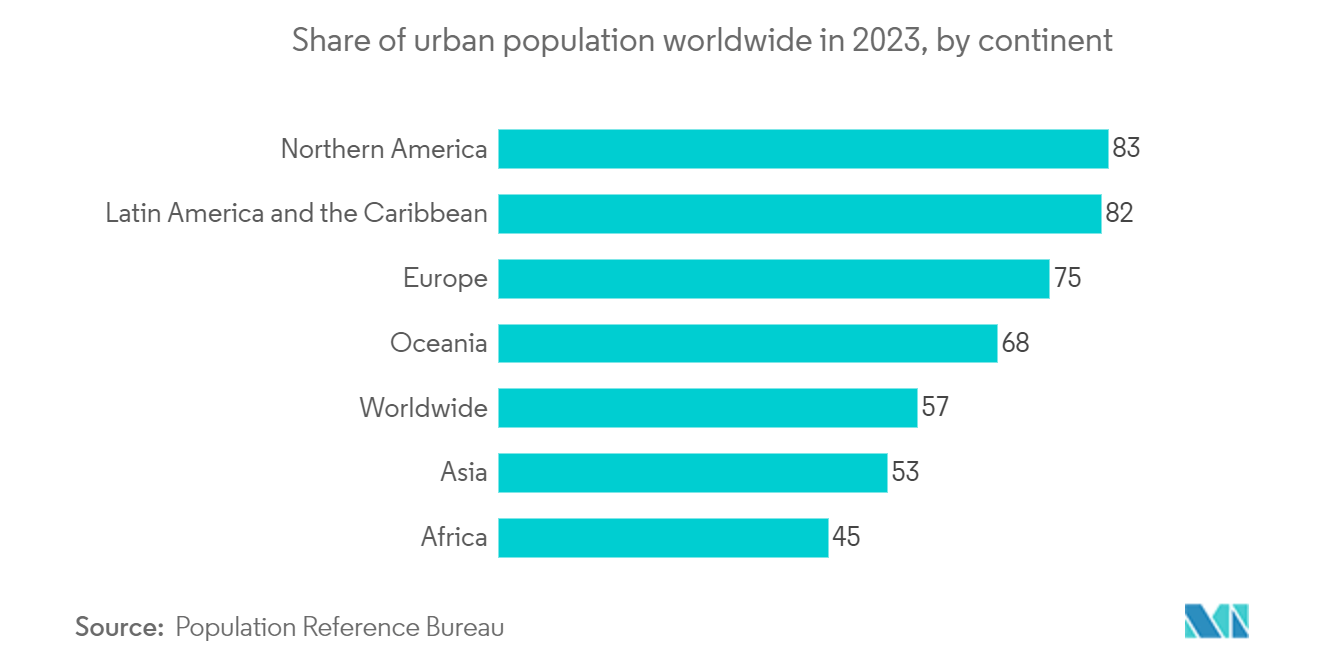
North America Holds Major Market Share
- North America is home to several significant device makers and network service providers who focus on testing and commercial deployment of solutions for industrial and commercial applications, creating a massive demand for the industry. Additionally, the market is anticipated to contribute a sizeable share due to rising internet penetration, the continued rollout of high-speed internet infrastructure networks, the rise in smart city initiatives, and rising levels of disposable income, especially in economies like the United States, Canada, Brazil, and other nations in the region.
- The United States and Canada have developed economies that enable them to invest heavily in R&D. Rising digitization throughout the industrial emphasis areas, steady technological advancements, and rising penetration of smart connected devices have all contributed to the growth of the North American Narrowband IoT market. The increased usage of connected devices and associated network infrastructure, as well as the increased collaboration of network, hardware, and software providers, are the primary drivers that assist in expanding the IoT market in the North American region.
- According to Cisco, the United States and Canada are expected to have the highest average per capita devices and connections by 2022. Moreover, awareness about IoT devices in industries is significantly higher in the region compared to others. According to a study by Mendix, 78% of US manufacturing workers welcome digitalization; eight in ten manufacturing workers are interested in learning new digital skills. Such a rise in IoT devices would drive the demand for the studied market.
- In September 2022, The National Institute of Standards and Technology (NIST) issued Draft Security Recommendations for IoT Devices in the United States. Because IoT regularly poses a cybersecurity risk through hacks and data breaches, the NIST's Core Baseline highlights recommended security features for manufacturers to incorporate into their IoT devices and guidelines for consumers to look for on a device's box or online description while shopping.
- Companies like AT&T had launched NarrowBand IoT Network to cater to customers' business needs, providing them with a range of IoT offerings, including smart lighting solutions. Over the next 20 years, the cities in the country are planning to invest about USD 41 trillion to develop smart cities, smart energy, and other connected technologies, including smart lighting. According to the federal government, the Climate Smart Buildings Initiative is planned to boost performance contract spending from USD 251 million in FY2021 to USD 1.2 billion per year by 2030, a fivefold increase. Such a massive rise in spending on smart buildings would create several opportunities for the smart lighting players to develop new products to capture the market share.
- Many governments initiated smart lighting schemes with long-term goals in mind. Saint-Laurent, a borough of Montreal, Canada, launched an initiative to create a smart lighting system. The city saved 50% on energy expenditures, nearly 55% on maintenance costs, and reduced light pollution. Around 90% of the streetlamps on Saint-Laurent's roads have been replaced with LEDs. This replacement work was completed as part of numerous capital investment initiatives that the Ville de Montréal and the Arrondissement de Saint-Laurent run. The City of Montreal paid about USD 110 million in a project to replace 132,000 street lighting in 19 municipalities with LEDs. Such a rise in smart lighting is expected to create opportunities for the studied market to grow.
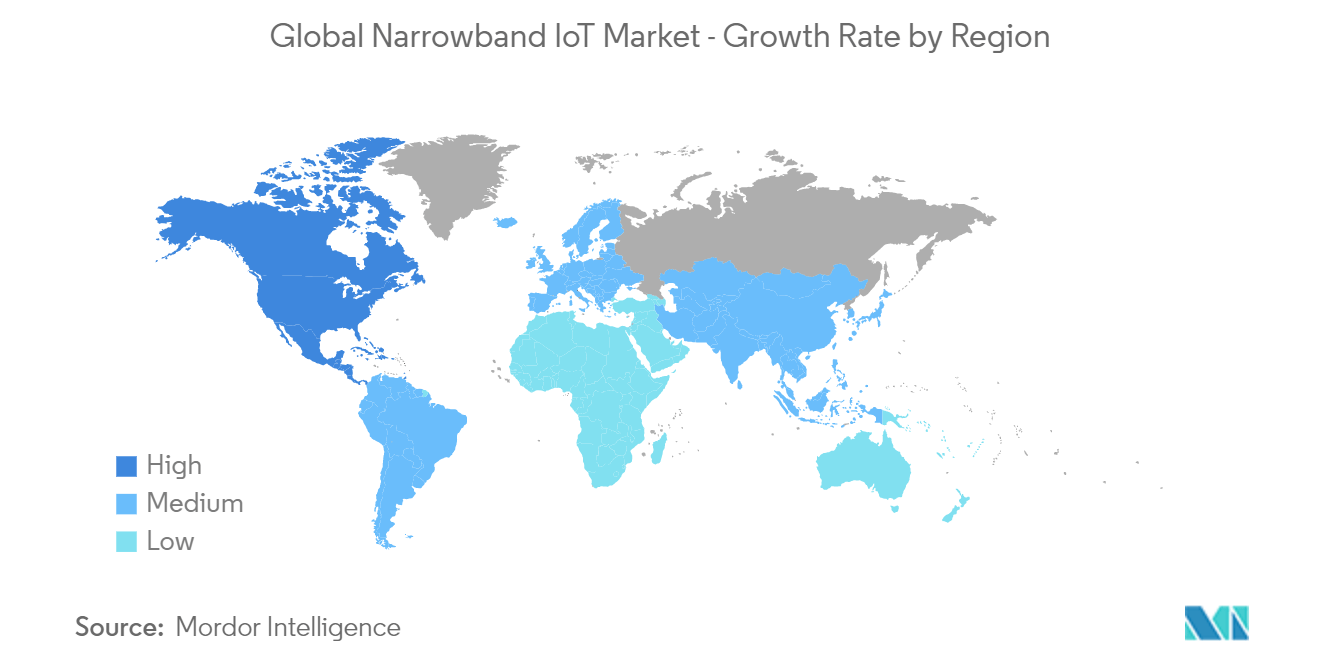
Narrowband IoT Industry Overview
The Global Narrowband IoT Market is moderately consolidated, with the presence of a few major companies. The companies continuously invest in strategic partnerships and product developments to gain more market share. Some of the recent developments in the market are:
- September 2022 - Sateliot, a satellite communication operator, announced that it is developing direct-to-satellite narrowband IoT (NB-IoT) connectivity using Low Earth Orbiting (LEO) satellites. This week, the business announced a collaboration with Amazon Web Services (AWS) to develop a completely virtualized cloud-native 5G core for its NB-IoT service, which is slated to be commercially operational in the second half of 2023. Rather than selling the service itself, Sateliot intends to provide seamless coverage for cell operators through roaming agreements.
- September 2022 - Vodafone NZ, New Zealand's IoT connection provider, has worked with Digital Matter, a global player in GPS and IoT asset tracking hardware and software, to provide complete IoT asset tracking solutions for New Zealand businesses. Vodafone NZ has created a fully managed, end-to-end asset management solution by combining numerous battery-powered IoT asset monitoring devices from Digital Matter with white-label asset tracking software, best-in-class LTE-M (Cat-M1), NB-IoT connection, and in-house technical support.
Narrowband IoT Market Leaders
-
Huawei Technologies Co., Ltd
-
Ericsson Corporation
-
Qualcomm Technologies
-
AT&T Inc
-
Verizon Wireless
*Disclaimer: Major Players sorted in no particular order
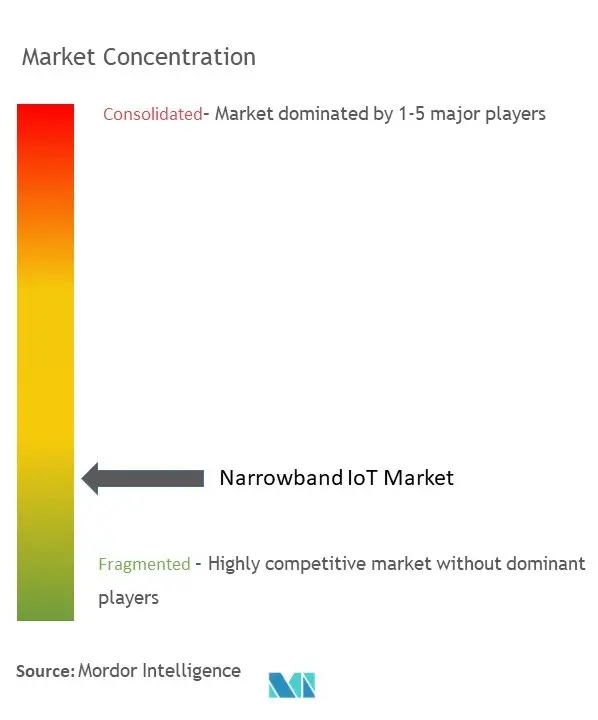
Narrowband IoT Market News
- March 2023 - Monogoto, a cloud-based cellular network provider, has announced a new roaming agreement with Skylo Technologies, a Non-Terrestrial Network (NTN) service operator. This new partnership lowers developers' barrier to adding satellite connectivity to existing public and/or private networks on Monogoto Cloud, giving the world's most economical and accessible solution for NB-IoT Satellite connectivity for asset monitoring solutions. Also, SODAQ, a low-power tracking and sensing system developer, will unveil a new asset-tracking trial kit using Monogoto connection and network.
- January 2023- Airgain, Inc., a global provider of wireless connectivity solutions that includes embedded components, external antennas, and integrated systems, has announced a partnership with Deutsche Telekom IoT to connect its asset tracking devices with Europe's leading IoT network coverage for a best-in-class solution. These devices have industry-leading battery life of up to 14 years, cutting-edge cellular technologies such as LTE-M and NarrowBand IoT (NB-IoT), and the ability to effortlessly interface with any business software stack.
Narrowband IoT Market Report - Table of Contents
1. INTRODUCTION
- 1.1 Study Deliverables
- 1.2 Study Assumptions
- 1.3 Scope of the Study
2. RESEARCH METHODOLOGY
3. EXECUTIVE SUMMARY
4. MARKET DYNAMICS
- 4.1 Market Overview
- 4.2 Market Drivers
- 4.3 Market Restraints
- 4.4 Value Chain Analysis
-
4.5 Porters Five Force Analysis
- 4.5.1 Threat of New Entrants
- 4.5.2 Bargaining Power of Buyers/Consumers
- 4.5.3 Bargaining Power of Suppliers
- 4.5.4 Threat of Substitute Products
- 4.5.5 Intensity of Competitive Rivalry
- 4.6 Assestment of the Impact of COVID-19 on the Industry
5. MARKET SEGMENTATION
-
5.1 By Component
- 5.1.1 Network
- 5.1.2 Module
-
5.2 By Deployment
- 5.2.1 Standalone
- 5.2.2 In-band
- 5.2.3 Guard-band
-
5.3 By Device Type
- 5.3.1 Wearables
- 5.3.2 Tracker
- 5.3.3 Smart Meter
- 5.3.4 Smart Lighting
- 5.3.5 Alarm & Detector
- 5.3.6 Others
-
5.4 By Application
- 5.4.1 Smart Cities
- 5.4.2 Transportation & Logistics
- 5.4.3 Energy & Utilities
- 5.4.4 Retail
- 5.4.5 Agriculture
- 5.4.6 Others
-
5.5 By Geography***
- 5.5.1 North America
- 5.5.1.1 United States
- 5.5.1.2 Canada
- 5.5.2 Europe
- 5.5.2.1 Germany
- 5.5.2.2 United Kingdom
- 5.5.2.3 France
- 5.5.3 Asia
- 5.5.3.1 India
- 5.5.3.2 China
- 5.5.3.3 Japan
- 5.5.4 Australia and New Zealand
- 5.5.5 Latin America
- 5.5.5.1 Brazil
- 5.5.5.2 Argentina
- 5.5.6 Middle East and Africa
- 5.5.6.1 United Arab Emirates
- 5.5.6.2 Saudi Arabia
6. COMPETITIVE LANDSCAPE
-
6.1 Company Profiles*
- 6.1.1 Huawei Technologies Co., Ltd
- 6.1.2 Ericsson Corporation
- 6.1.3 Qualcomm Technologies
- 6.1.4 AT&T Inc
- 6.1.5 Verizon Wireless
- 6.1.6 Nokia Corporation
- 6.1.7 Vodafone Group
- 6.1.8 SEQUANS Communications
- 6.1.9 Intel Corporation
- 6.1.10 Intel Corporation
- 6.1.11 Deutsche Telekom
- 6.1.12 Twilio
- 6.1.13 SEQUANS Communications
7. INVESTMENT ANALYSIS
8. MARKET OPPORTUNITIES AND FUTURE TRENDS
** Subject To AvailablityNarrowband IoT Industry Segmentation
NarrowBand-Internet-of-Things (NB-IoT) is a standards-based low power wide area (LPWA) technology that has been created to enable a variety of new IoT devices and applications. NB-IoT dramatically improves user device power consumption, system capacity, and spectrum efficiency, particularly in deep coverage. For a wide range of use scenarios, battery life of more than ten years can be supported.
The Narrowband IoT market is segmented by component (network, module), by deployment (standalone, in-band, guard-band), by device type (wearables, tracker, smart meter, smart lighting, alarm & detector, and others), by application (smart cities, transportation & logistics, energy & utilities, retail, agriculture and others), and geography (North America [United States, Canada], Europe [United Kingdom, Germany, France, Rest of Europe], Asia Pacific [India, China, Japan, Rest of Asia Pacific], Latin America [Brazil, Argentina, Rest of Latin America], Middle East and Africa [United Arab Emirates, Saudi Arabia, Rest of Middle East and Africa]). The market sizes and forecasts are provided in terms of value in USD for all the above segments.
| By Component | Network | |
| Module | ||
| By Deployment | Standalone | |
| In-band | ||
| Guard-band | ||
| By Device Type | Wearables | |
| Tracker | ||
| Smart Meter | ||
| Smart Lighting | ||
| Alarm & Detector | ||
| Others | ||
| By Application | Smart Cities | |
| Transportation & Logistics | ||
| Energy & Utilities | ||
| Retail | ||
| Agriculture | ||
| Others | ||
| By Geography*** | North America | United States |
| Canada | ||
| By Geography*** | Europe | Germany |
| United Kingdom | ||
| France | ||
| By Geography*** | Asia | India |
| China | ||
| Japan | ||
| By Geography*** | Australia and New Zealand | |
| Latin America | Brazil | |
| Argentina | ||
| Middle East and Africa | United Arab Emirates | |
| Saudi Arabia |
Narrowband IoT Market Research FAQs
How big is the Narrowband IoT Market?
The Narrowband IoT Market size is expected to reach USD 7.91 billion in 2024 and grow at a CAGR of 31.82% to reach USD 31.47 billion by 2029.
What is the current Narrowband IoT Market size?
In 2024, the Narrowband IoT Market size is expected to reach USD 7.91 billion.
Who are the key players in Narrowband IoT Market?
Huawei Technologies Co., Ltd, Ericsson Corporation, Qualcomm Technologies, AT&T Inc and Verizon Wireless are the major companies operating in the Narrowband IoT Market.
Which is the fastest growing region in Narrowband IoT Market?
Asia Pacific is estimated to grow at the highest CAGR over the forecast period (2024-2029).
Which region has the biggest share in Narrowband IoT Market?
In 2024, the North America accounts for the largest market share in Narrowband IoT Market.
What years does this Narrowband IoT Market cover, and what was the market size in 2023?
In 2023, the Narrowband IoT Market size was estimated at USD 5.39 billion. The report covers the Narrowband IoT Market historical market size for years: 2019, 2020, 2021, 2022 and 2023. The report also forecasts the Narrowband IoT Market size for years: 2024, 2025, 2026, 2027, 2028 and 2029.
Narrowband IoT Industry Report
Statistics for the 2023 Narrowband IoT market share, size and revenue growth rate, created by Mordor Intelligence™ Industry Reports. Narrowband IoT analysis includes a market forecast outlook to 2029 and historical overview. Get a sample of this industry analysis as a free report PDF download.



